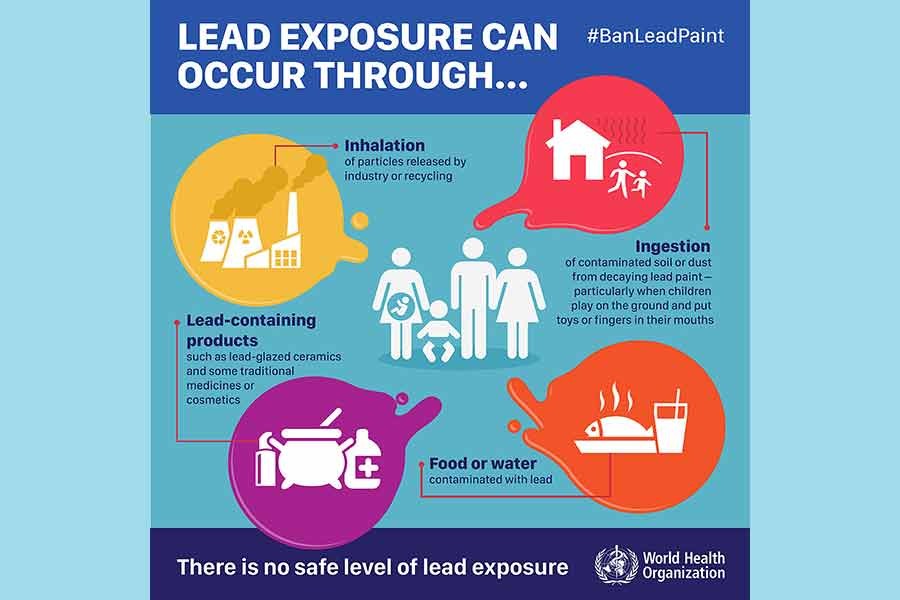Lead is one of the most commonly available chemical compounds that is found in the all parts of environment-- the air, the soil, the water, and even inside our homes. It is said that any level of lead in the body is harmful. Lead poisoning is one of the most pervasive, well-established, and preventable environmental hazards globally. Globally many countries (100+) are exposed to lead at an alarming level. Basically, lead poisoning is directly causing several diseases and even responsible for death in many countries, but still, we cannot call lead poisoning as 'pandemic' due to the binding of the definition. In simple terms, we understand pandemic as the spread of a disease over multiple countries or continents and lead poisoning is an active source of many deadly disease across continents. Still it is not a pandemic situation even though it is causing greater harm than a pandemic situation!
Globally, an estimated 674,000 deaths are annually attributed to lead exposure, mainly from cardiovascular diseases, and more than 600,000 cases of child brain disability. In 2019, The Institute for Health Metrics and Evaluation (IHME) reported global 900,000 deaths and 21.7 million years of healthy life lost (disability-adjusted life years, or DALYs) worldwide due to the lead poisoning. Among deaths and healthy-life lost, low- and middle-income countries contributed the most. Furthermore, the most serious lead exposure is responsible for 62.5 per cent of the global burden of developmental intellectual disability whose cause is not obvious, 8.2 per cent of the global burden of hypertensive heart disease, 7.2 per cent of the global burden of the ischemic heart disease and 5.7 per cent of the global burden of stroke.
Considering the widespread magnitude of leading poisoning, WHO and International agencies are campaigning for a concerted global effort to eliminate lead poisoning. The voices included the governments of all nations to i) ban the manufacture, import, and export of lead-containing fuels, paints, plumbing fixtures, and plastics; ii) replace lead content, wherever possible, in all consumer and commercial products; iii) increase the training of health professionals in the identification and prevention of lead poisoning.
Despite the emphasis on lowering lead exposures over past few decades, the problem is still ubiquitous, especially in low-to-middle-income countries. Lead contamination is often found in consumer products. In addition, lead-based paint is still present in houses and schools. These contaminations invite scope for widespread exposures. Lead-based paints are being used in many countries. Recycling of lead batteries is ongoing. These are substantial exposures to the vicinity of the surrounding community.. Exposure to lead also occurs from food, or ceramics or cans or aluminum cookware and from the proximity to hazardous waste sites.
Lead exposure can cause stunting among children where poor and inadequate nutrition is prevalent. The burden of disease and disability due to lead poisoning falls disproportionately on low-income and minority communities globally. Acute fatalities in children due to lead poisoning have largely been eliminated in high-income countries but it still occurs in low- and middle-income countries.
The economic cost of lead poisoning is substantial, primarily due to lost lifetime and economic productivity. The economic cost for low- and middle-income countries (LMIC) is estimated to be 977 billion dollars annually, whereas the cost in the U.S. is estimated to be 50 billion dollars. But prevention is cost-beneficial. This compares favourably with the most widely accepted form of public health intervention, childhood vaccination, which is estimated to return 5.30 to 16.50 dollars for every dollar spent.
Taking lead exposure into account, considerable progress has been achieved over the last few decades to reduce the health burdens. By doing so, average blood lead levels have declined in many countries. An international treaty (The Basel Convention) places restrictions on the transfer of lead-containing waste among countries and makes recommendations for the proper handling of lead containing waste. However, the Convention has not been ratified by the U.S., which is a large exporter of lead-containing waste, and has failed to eliminate widespread transfers of this waste to low- and middle-income countries.
However, it must not be forgotten that lead exposure causes death and disability that are almost entirely preventable with a very high benefit-to-cost ratio. For Bangladesh, prudent public health decision should not wait. According to the Institute of Health Metrics Evaluation, Bangladesh has the world's fourth-highest rate of death due to lead exposure with an average population blood lead level of 6.83 ?g/dL, which is the eleventh highest in the world. In such a situation, it is high time that the government put in place necessary regulations and strong monitoring to be able to avert terrible consequences.
Dr Mahfuzar Rahman, Country Director, Pure Earth, Bangladesh


